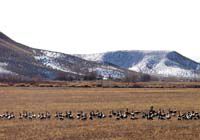| Canadian geese pause for a snack out of a farmer’s field in Emery County. |
You may not view Emery County as an epicenter for birds and migration but the area is a prime throughfare for north and southbound birds.
As far as geese are concerned, hundreds make seasonal migrations through Emery County in both spring and fall. Some geese simply pass through the county stopping to eat and rest. Others nest and rear young here. Every year, a flock of geese winters in Emery County. They rest in the ponds of the Hunter Power Plant, Desert Lake, Huntington North State Park, Millsite, farm ponds, canals and the Price River.
These geese feed in farmer’s fields, eating waste crops, alfalfa and whatever looks green or edible. They also forage in open water, eating aquatic plants and insect life.
| Some Canadian geese make Emery County their home. |
Some snow geese will also pass through the county but the great majority are the Canada geese.
Besides the resident population of Canada geese which number around 100, which summer in Emery County there are many more which pass through during spring and fall migration. These birds will nest in northern Utah, Idaho, Montana and go as far as Canada. Birds, migrating south, spend winters in the Gulf of California, Mexico, and the Baja Pennisula.
Desert Lake just east of Elmo is a prime bird watching environment. The bird list for Desert Lake goes on and on including birds such as the common loon, grebes, horned, eared, western and pied-billed. White pelicans have also made appearances at Desert Lake. Some are common, some are residents, some are uncommon and some are migrant bird populations. Species of birds include herons, waterfowl, hawks, pheasants, rails, sandpipers, gulls, terns, doves, owls, goat suckers, swifts, woodpeckers, flycatchers, swallows, jays, wrens, thrushes, shrikes, starlings, dipper, wood warblers, blackbird, finches and sparrows. All of these birds visit Desert Lake from time to time with many varieties of each bird.
The Canada goose, Branta canadensis, is a common breeding bird throughout Utah, and many populations in the state are year-round residents. It also breeds in Alaska, Canada, and the northern United States, and winters south to northern Mexico. Breeding takes place in a wide variety of habitats, but usually in close proximity to water. Nests are typically large structures of plant material lined with down that are usually in a small depression on the ground near water. Eggs are typically laid in late April, and often number five or six, though as few as two or as many as 11 eggs may be laid. Incubation is done by the female alone for 25-30 days while the male guards the nest site. Young are tended by both parents and are able to fly after nine weeks. Young remain with the parents until the following spring. Canada geese feed on a variety of plant material, including shoots, grasses, and grains, as well as on aquatic invertebrates.

